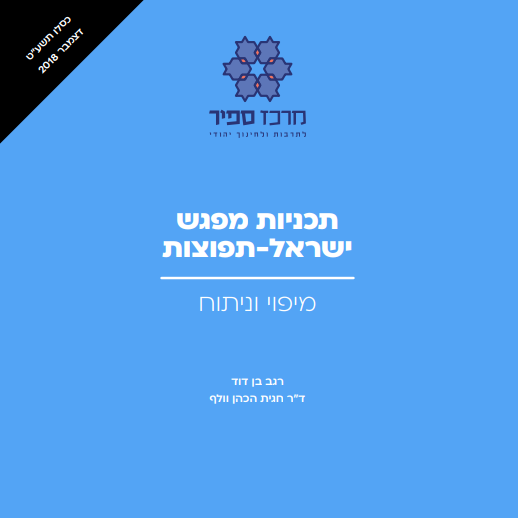Research Authors:
Regev ben David and Dr. Hagit Hacohen Wolf
December 2018
Abstract
Recent years have seen increasing attention given to the relations between Israel and the Diaspora. In the looming shadow of the claims of an emerging crisis between Israel and world Jewry, many individuals and organizations have launched diverse programs that deal with these relations. This awakening has made the need for a mapping and analysis of the current programs more acute.
The Sapir Center has initiated the first mapping process of its kind that quantitatively analyzes the programs that sponsor planned encounters between Israeli Jews and Diaspora Jews.
The classification and analysis of the programs revolve mainly around the conceptual frameworks (paradigms) about Israel-Diaspora relations that inform the programs: the classic Zionist paradigm and the Jewish Peoplehood paradigm The classic Zionist paradigm views Israel as the center and categorizes Jews in those who live there and those who live elsewhere. Programs operating according to this paradigm will strive to strengthen Israel’s centrality among the Jews of the Diaspora.
The Jewish Peoplehood paradigm centers around a perception of reciprocity and partnership. It attributes importance to strengthening Jewish communities and accords value to the existence of a living vibrant Judaism in many places around the world, including Israel.
Conclusions
- There are many more encounter programs for Diaspora Jews than there are for Israeli Jews. More than 80% of all participants in programs that include an encounter are from the Diaspora.
- Classifying the programs by paradigm reveals a contrasting picture vis-à-vis the ratio of participants between classic Zionist paradigm programs (where Diaspora Jews constitute 90%) and Jewish peoplehood paradigm programs (a symmetrical ratio).
- More Israelis participate today in programs based on the Jewish peoplehood paradigm than on the classic Zionist paradigm. Nevertheless, there is a significant difference in the character of the programs: most of the high intensity level meetings (such as ‘Taglit Birthright’) are based on the classic Zionist paradigm, while the majority of meetings in Jewish peoplehood paradigm programs are via an online connection (twin schools).
- In recent years, there has been an increase in the number of programs based on the Jewish peoplehood paradigm and that turn to Israelis as their primary target audience. Furthermore, in some of the veteran programs cautious conceptional changes are occurring with a gradual transition from the classic Zionist paradigm towards the Jewish peoplehood paradigm.
Recommendations:
- Drawing on the analysis of the current situation, the discussion section offers several possible directions for expanding the Jewish Peoplehood paradigm to new types of programs.
- In order to promote the overall field of the encounter programs, there is a need for additional research on how they influence participants, including ‘Second Circle’ programs not included in this study.
- 2. There is a need to create a tighter connection between the organizations operating in this field and the creation of joint conceptualization and databases to strengthen both the research and relevant educational activity.


